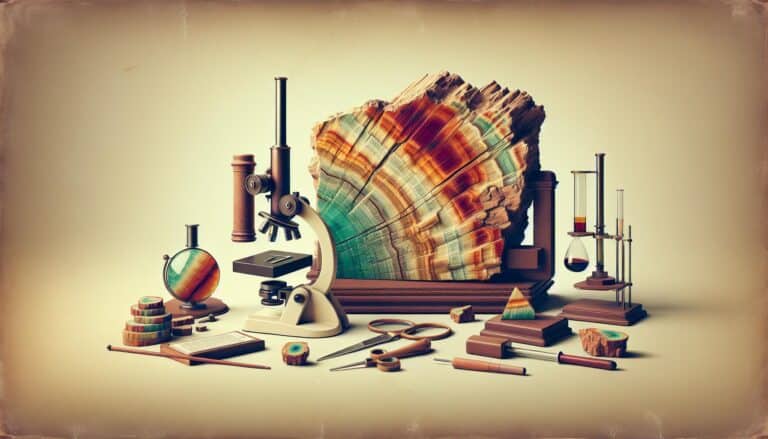Discovering the secrets of minerals like datolite is like unlocking a hidden chapter of Earth’s history.
You’ve probably stumbled upon its unique charm or heard of its uses in jewelry and healing practices. But how do you differentiate datolite from other minerals?
Identifying datolite doesn’t have to be a daunting task. With its distinct features and properties, you’ll soon be spotting this mineral like a pro.
Whether you’re a seasoned collector or a curious newcomer, understanding the basics is your first step to mastering the art of mineral identification.
To identify datolite, observe its glassy luster, translucent appearance, and color range from colorless to green, yellow, or pink. Check for rhomboidal crystals. Perform a streak test (white streak), hardness test (5-5.5 on Mohs scale), and refractive index test (1.627-1.688). Datolite is non-magnetic and displays single refraction.
How to Identify datolite Through Testing
When you’re keen to pinpoint datolite, several testing methods can help authenticate your find. From simple observation to specific scientific tests, you’re equipped to uncover datolite’s true nature.
Visual Inspection
Start with a comprehensive visual inspection. Look for datolite’s typical features: glassy luster, translucent to semi-transparent appearance, and a color range that spans from colorless to pastel shades of green, yellow, or pink. Also, check for its common rhomboidal or wedge-shaped crystals.
The Streak Test
Conduct a streak test using an unglazed porcelain plate, which can reveal the true color of the mineral. Datolite typically leaves a white streak, but don’t be surprised if there’s little to no streak—it’s a common result for harder minerals.
Magnet Test
Try the magnet test. Datolite is non-magnetic, so if your sample is attracted to a magnet, it’s likely not datolite.
Hardness Test
Perform a hardness test. Datolite ranks at about 5 to 5.5 on the Mohs scale of hardness, meaning it can scratch glass and is slightly harder than a steel knife blade.
Birefringence Test
Inspect for birefringence using a polariscope. Datolite may exhibit weak birefringence when viewed through crossed polarizing lenses, presenting a play of color or light and dark bands.
Checking The Diaphaneity
Assess the diaphaneity – the mineral’s ability to transmit light. Datolite ranges from transparent to translucent, so holding it up to a light should let some degree of light pass through.
Single or Double Refraction
Determine if the mineral shows single or double refraction. Place a dot on a piece of paper and look through the crystal. If datolite, you should see a single dot due to its isotropic nature.
Refractive Index Test
Implement a refractive index test if you have access to a refractometer. Datolite’s refractive index falls between 1.627 and 1.688, distinct against the scale for identifying various minerals.
Finding The Specific Gravity
Find the specific gravity by weighing the mineral in air and then suspended in water. Datolite’s specific gravity typically lies around 2.8 to 3.0, providing insight into its identity when compared to similar minerals.
| Environment | Weight in Air | Weight in Water | Specific Gravity |
|---|---|---|---|
| Datolite | X | Y | 2.8 – 3.0 |
Identifying Datolites in the Field
When you’re identifying datolites in the field, take note of surrounding rocks and mineral formations. Datolite often associates with basaltic rocks and copper deposits.
Recognizing Potential Datolite Rocks
Finally, recognize potential datolite rocks by their formation environments. Scout for skarns, metamorphosed limestone, or hydrothermally altered rocks—typical habitats for datolite to reside.
Armed with these methods and a keen eye for detail, you’re now prepared to delve deeper into the world of mineral identification. With each test, you’ll fine-tune your ability to distinguish datolite from its many look-alikes.
Physical Characteristics of datolites

In your quest to accurately identify datolites, it’s crucial to examine their physical properties. Datolites typically manifest in a range of colors, from colorless to shades of white, yellow, green, and pink. This variability can at times complicate identification, but color remains a helpful starting point.
You’ll find that datolite has a vitreous to greasy luster, which gives it a shiny appearance akin to glass when observed under light. This luster is particularly noticeable on freshly broken or cleaved surfaces. Another definitive characteristic is the crystal structure. Datolites crystallize in the monoclinic system, showing prismatic, tabular, or sometimes acicular crystal habits.
When assessing the transparency of datolite, you’ll note that it ranges from transparent to translucent. Translucence in minerals like datolite often enhances their appeal, especially for collectors and gemstone enthusiasts. The fractures in datolite are typically conchoidal to uneven, which can be spotted upon a closer look at broken pieces.
The specific gravity of datolite generally falls between 2.9 to 3.0. Here is a handy reference for the typical datolite specific gravity:
| Property | Value |
|---|---|
| Specific Gravity | 2.9 – 3.0 |
Lastly, keep an eye out for the Mohs hardness of the datolite you’re examining. It ranges from 5 to 5.5, indicating a relatively good resistance to scratching. Recognizing these physical characteristics is pivotal as they provide immediate clues even before delving into more intricate tests and observations.
How Are datolite Formed?
Datolite’s formation is a process deeply intertwined with the geological activities that shape our planet. These intriguing minerals typically form in the vesicles or gas bubbles of basalt, a rock that comes from cooled lava. Geothermal activity plays a critical role in their creation.
During the cooling of lava, gases trapped within it form cavities, known as amygdules, in the volcanic rock. Over time, these cavities get filled with various minerals. When mineral-rich hydrothermal fluids seep into these cavities, datolite begins to crystallize. This freshwater influence is rich in the calcium borosilicate that comprises datolite.
- Basaltic Lava Flows set the stage for formation
- Amygdules become the birthplace of new datolite crystals
- Hydrothermal Fluids provide the necessary minerals
The interaction between these fluids and the chemical composition of the surrounding rock determines the crystal structure and size of the datolite that forms. Under optimal conditions, large crystal pockets can develop, leading to significant datolite deposits.
Beyond basalt, this process can also occur within other host rocks, like dolomite or limestone. These environments must provide specific conditions of high temperature and pressure nature needs to cultivate datolite crystals. It’s important to consider the regional geology when seeking datolite to understand these formative environments better.
Preparation for datolite Hunting
Before you embark on your adventure to find datolite, ensure that you’re well-prepared with the necessary equipment and have taken the appropriate safety measures. Proper preparation can make the difference between a fruitful expedition and a missed opportunity.
Gathering the Right Tools
To successfully identify datolite in the field, you’ll want to arm yourself with a few key tools:
- Geologist’s hammer: This is crucial for safely extracting samples.
- Hand lens or magnifier: To inspect the smaller details of your finds.
- Streak plate: Useful for conducting streak tests to determine the color of the mineral’s powder form.
- Hardness test kit: This may include a set of Mohs scale mineral picks.
- Magnet: To test for magnetism which datolite does not exhibit.
- Acid bottle with dilute HCl: For testing the reaction of potential datolite specimens in carbonate-rich rocks.
- Safety glasses and gloves: Always protect your eyes and hands from flying debris and sharp edges.
- Field notebook and pen: To take detailed notes about the location and characteristics of your finds.
Having the right tools not only aids in identification but also ensures that your specimens are collected responsibly and intact.
Safety Considerations
When searching for datolite, it’s paramount to prioritize your safety:
- Wear sturdy footwear: High-quality boots will protect your feet and provide stability on uneven terrain.
- Use protective gear: A hard hat, safety glasses, and gloves are non-negotiable when dealing with rocks.
- Be mindful of your surroundings: Loose rocks and steep inclines pose a falling hazard.
- Stay hydrated: Always bring enough water, especially if you’re hunting in remote or arid locations.
- First Aid Kit: A basic first aid kit can address minor injuries on the spot.
- Inform someone of your plans: Let a friend or family member know where you’re going and when you expect to return.
Remember, your well-being is priceless. Don’t compromise on safety for the sake of finding datolite.
Handling and Care of Found datolites

Cleaning Datolites
After you’ve successfully identified and collected datolite samples, proper cleaning is crucial to reveal their true beauty and characteristics. Start by gently brushing off any loose dirt using a soft-bristled brush. For more stubborn grime, soak your datolites in warm water with a bit of mild detergent. Use a toothbrush to carefully scrub them clean. Rinse thoroughly with clean water to remove any soap residue. Remember, some datolites can be delicate, so handle with care to avoid scratching or chipping them.
Avoid using harsh chemicals or ultrasonic cleaners as they can damage the mineral. For datolites with deep crevices, a gentle stream of water from a squeeze bottle can help dislodge any trapped dirt. If you come across tough stains, consider using diluted hydrochloric acid (HCl), but only if you’re experienced with handling chemicals and always wear protective gear.
Storing Datolites
Once your datolites are clean, it’s important to store them properly to prevent damage. Storage conditions should ensure minimal exposure to elements that can degrade the mineral:
- Wrap each specimen individually in tissue paper or place it in a polyurethane bag to prevent scratches.
- Use a sturdy container with padding to protect the datolites from physical shocks during handling and transport.
- Keep your storage area cool, dry, and away from direct sunlight to avoid the potential fading of colors or structural damage from temperature fluctuations.
For labeling, attach a small tag or label to each wrapped or bagged specimen, noting the date of collection, location, and any other relevant details. This practice keeps your collection organized and provides valuable information for future reference or if you decide to showcase your findings.
By maintaining a datolite collection with diligent cleaning and storage practices, you’ll ensure each piece retains its geological significance and aesthetic appeal for years to come. Remember that proper care begins from the moment you find your specimen until it takes its place among your carefully curated collection.
Conclusion: Confirming Datolite is Real
Armed with the right techniques you’re now poised to accurately identify datolite.
Remember that the true test lies in careful observation and a methodical approach to testing. Whether you’re out in the field or examining a potential find at home, your newfound knowledge is your best tool. Don’t forget the importance of handling your specimens with care to preserve their natural beauty and geological value. With these insights, you’re well on your way to becoming a savvy datolite collector.
Happy hunting!



![CT Rockhounding Sites in [year]: Ultimate Guide](https://observationhobbies.com/wp-content/uploads/2024/01/EwCpbYkKm-UMtRMdAcx1J-768x439.jpg)



